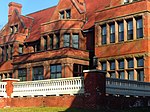Our Lady of the Valley High School
1981 disestablishments in New JerseyCatholic secondary schools in New JerseyHigh schools in Essex County, New JerseyOrange, New JerseyPrivate high schools in Essex County, New Jersey ... and 3 more
Roman Catholic Archdiocese of NewarkUse American English from March 2021Use mdy dates from March 2021
Our Lady of the Valley High School was a Catholic high school in Orange in Essex County, in the U.S. state of New Jersey, that operated under the supervision of the Roman Catholic Archdiocese of Newark. The school closed in June 1981.
Excerpt from the Wikipedia article Our Lady of the Valley High School (License: CC BY-SA 3.0, Authors).Our Lady of the Valley High School
Church Street,
Geographical coordinates (GPS) Address Nearby Places Show on map
Geographical coordinates (GPS)
| Latitude | Longitude |
|---|---|
| N 40.764888 ° | E -74.24895 ° |
Address
Church Street 560
07050
New Jersey, United States
Open on Google Maps








